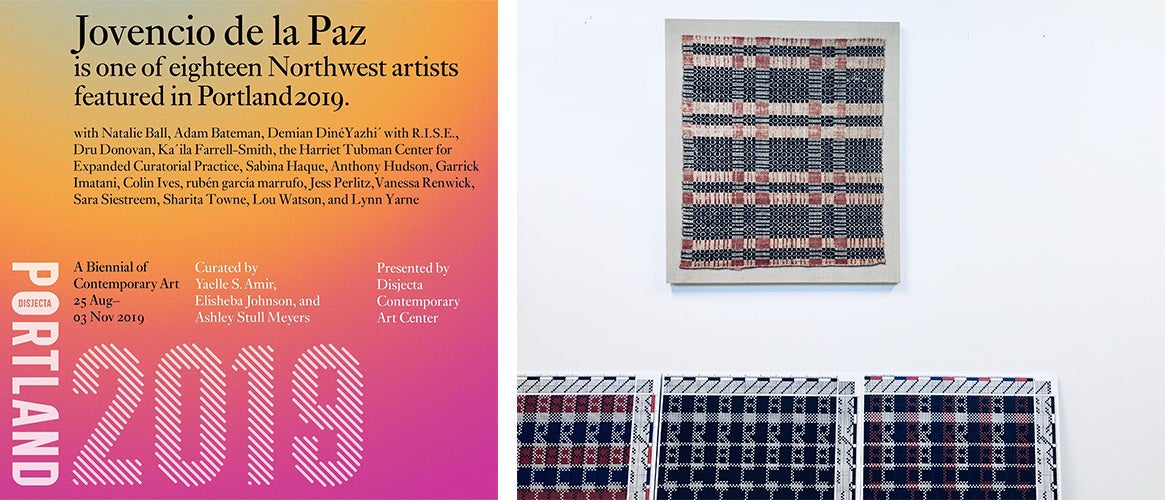
“Call Me Ishmael,” a machine writes in blue cursive.
“Some years ago—never mind how long precisely—having little or no money in my purse, and nothing particular to interest me on shore,” the script continues, slanting with the ebb and flow of the tide off the Oregon Coast.
This machine, “Wave Scribe”—which will write out the entire text of Herman Melville’s Moby Dick—is Colin Ives’ entry for the 2019 Portland Biennial.
Portland Biennial
August 25—November 3
Disjecta Contemporary
Art Center
8371 N. Interstate Ave.
Closing Reception & Catalogue
Release Party
6 to 9 pm Saturday, November 2
On August 24, the Disjecta Contemporary Art Center opened its 5th Portland Biennial, featuring the work of 18 artists based in the Pacific Northwest. Two of those artists are Department of Art faculty: Ives, associate professor and Art & Technology program director, and Jovencio de la Paz, assistant professor of art. Artist and alumna Natalie Ball (BA Art, Ethnic Studies ’05) also has work in the show.
The Biennial curators Yaelle S. Amir, Elisheba Johnson, and Ashley Stull Meyers chose artists “whose practices are rooted in a rigorous approach to sociopolitical commentary, presenting diverse perspectives on historical and contemporary narratives unique to the Pacific Northwest.”
This is the first Portland Biennial for both Ives and de la Paz. For Ives’ entry, “Wave Scribe,” he digitized his own cursive handwriting. As the machine processes the text, the height and slant of the script respond to the current rise, fall, and direction of ocean waves off the coast.
 Colin Ives' piece 'Wave Scribe' and Disjecta's promotion for the Portland Biennial
Colin Ives' piece 'Wave Scribe' and Disjecta's promotion for the Portland Biennial
“The text of this great American novel, which famously reflects a cultural upheaval in our relationship to ‘nature’ and the effects of technology brought on by the industrial revolution, is altered in form—passing through my handwriting and by way of the unceasing current of wave upon ocean wave,” Ives explained. “While scripts are thought to have begun as notches, knots, and notations to keep track of material goods for commerce, this new materialized language allowed for new forms of transmission—resulting in literature and other poetic and philosophical plays of language forever changing our individual and collective brains.”
De la Paz, an artist who primarily works in fibers, submitted the piece “Options for a Racist,” which features overshot textiles as well as digital prints of weave drafts, or diagrams for weavings, embedded with patterned text.
Since 2015, de la Paz has been confronting the history of Oregon’s 19th-century exclusion laws, designed by then legislator Peter Hardeman Burnett, which prohibited African Americans and other people of color from living in the territory.
Overshot weavings, de la Paz explained, originate from a technique developed by American Colonists to replicate more elaborate European textiles, which they could not afford to bring with them crossing the Atlantic. These textiles became associated with plantation and slave owners as a symbol of an ideal upper-class white domesticity. In contrast to the tradition of quilting, a material culture that crosses socio-economic classes, these weavings were a luxury object African Americans and other minority groups could not afford.
 Disjecta's promotion for the Portland Biennial and Jovencio de la Paz's artwork 'Options for a Racist'
Disjecta's promotion for the Portland Biennial and Jovencio de la Paz's artwork 'Options for a Racist'
“Referring to a specific Colonial American overshot coverlet, attributed to the collection of the Hardeman Burnett family, I have been unpacking the ways in which histories of exclusion and trauma are embedded in the visual and material language of coverlets,’ de la Paz said. “These textiles, popular today as a signifier of ‘simpler times’ and American domestic idealism, play the duplicitous role as a simultaneous signifier of white nationalism.”
“It is a great honor to be part of this show, especially given the curators’ unique sensitivity to sociopolitical narratives that have often gone unexamined or have been intentionally obscured over the course of the last several decades,” de la Paz added.
The Biennial, held at the Disjecta Contemporary Art Center in Portland, runs through November 3, when the center will release a catalogue.
